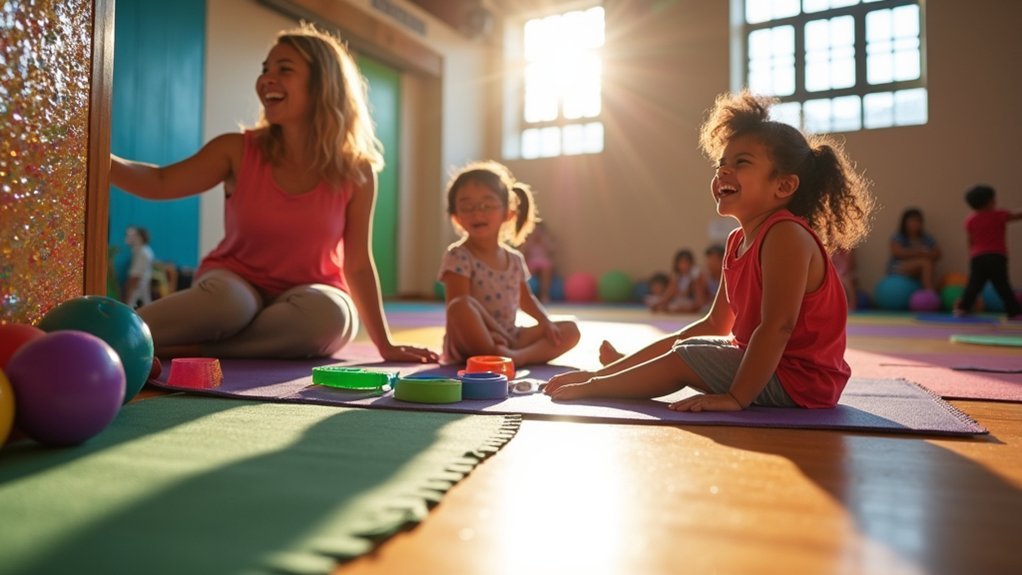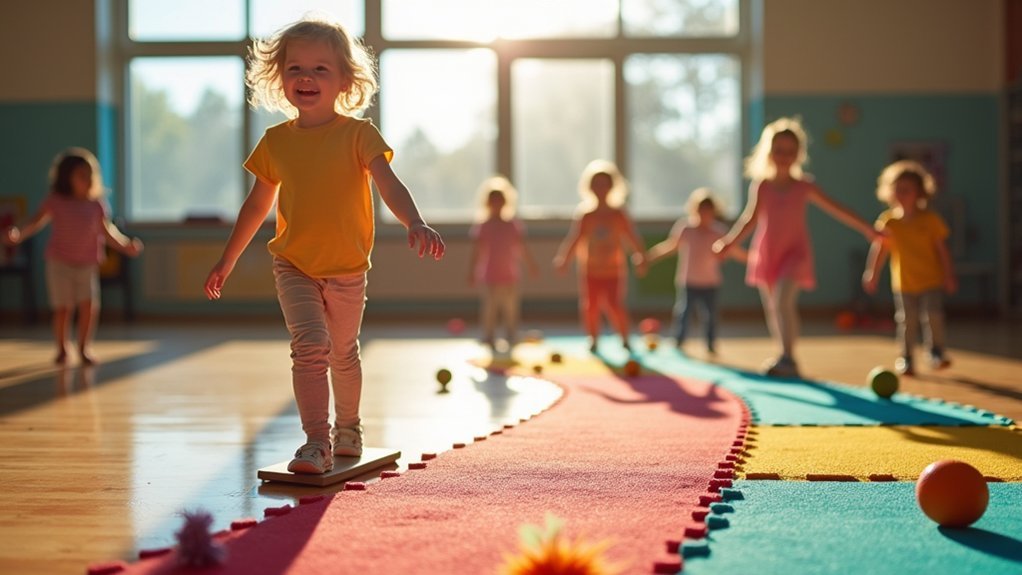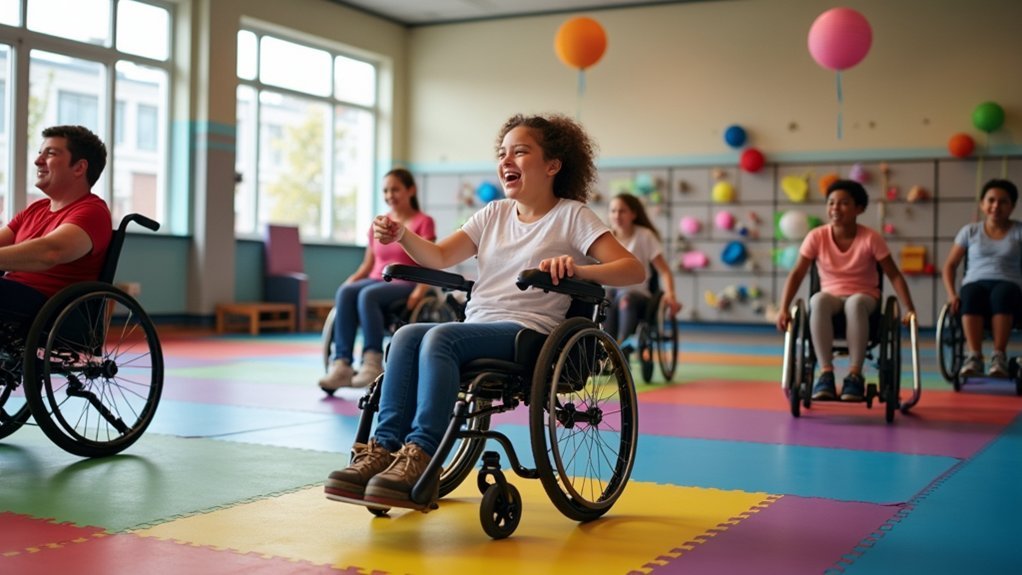Sensory tools transform disability exercise by targeting the body’s ability to organize sensory information, which affects movement quality and engagement. You’ll find these tools—like textured mats, weighted equipment, and balance boards—enhance body awareness while making physical activity more enjoyable and accessible. They provide essential proprioceptive feedback that helps individuals navigate their surroundings with greater confidence. By customizing sensory experiences to specific needs, you can achieve up to 30% higher motivation levels and markedly improved motor skills development.
Sensory Integration: The Foundation of Adaptive Movement

While many exercise programs focus primarily on strength or endurance, sensory integration forms the critical foundation upon which all adaptive movement is built.
When you understand that 1 in 6 children experience sensory processing challenges, you’ll recognize why tailored sensory activities are essential for successful physical development.
Your body’s ability to organize sensory information directly impacts motor skills and movement efficiency. By incorporating sensory tools like textured mats and weighted equipment, you’re enhancing body awareness and creating pathways for improved coordination.
These tools don’t just develop physical skills—they support emotional regulation too.
Structured activities targeting vestibular and proprioceptive inputs help your brain interpret environmental information correctly, enabling more confident, independent movement.
For those with disabilities, effective sensory integration transforms challenging exercises into accessible, empowering experiences.
Enhancing Motivation Through Multi-Sensory Exercise Tools
Sensory integration lays the groundwork, but motivation drives consistent participation in exercise programs. When you incorporate multi-sensory exercise tools, you’ll notice children with disabilities engage more enthusiastically in physical activities.
Research confirms that colorful equipment and music—visual and auditory stimuli—improve focus and enjoyment, leading to longer exercise sessions.
Vibrant colors and rhythmic sounds transform exercise from obligation to joy, extending engagement naturally.
Textured mats and balance boards encourage tactile exploration, helping children develop a positive association with movement. Programs utilizing these tools report a 30% increase in motivation levels, promoting sustained engagement in exercise routines.
Beyond physical benefits, these sensory-rich environments support emotional regulation and decreased anxiety, making children more willing to try new activities.
Creating Accessible Sensory Pathways for Balance Development

As children with disabilities navigate their physical development, accessible sensory pathways become essential foundations for building balance skills. You’ll find these pathways effectively engage multiple senses, promoting proprioceptive integration through textured surfaces, varied lighting, and sound elements that enhance coordination and body awareness.
| Sensory Element | Benefit | Implementation |
|---|---|---|
| Textured Surfaces | Improves tactile processing | Foam mats, bumpy tiles |
| Sound Features | Provides auditory guidance | Chimes, musical pathways |
| Visual Cues | Enhances focus | Colored markers, LED lights |
| Movement Stations | Builds gross motor skills | Balance beams, stepping stones |
Research shows structured sensory pathways reduce anxiety while improving focus and confidence. You can customize these experiences to address specific sensory processing challenges, creating engaging environments where children safely practice balance development consistently across schools and therapy centers.
Proprioceptive Feedback: How Sensory Tools Build Body Awareness
Proprioceptive awareness forms the foundation upon which children with disabilities build meaningful connections between their bodies and the surrounding environment.
When you introduce specialized sensory tools like weighted blankets and therapy balls, you’re providing essential deep pressure input that enhances this awareness and promotes self-regulation in those with sensory processing challenges.
You’ll notice significant improvements in motor skills when children engage in proprioceptive feedback activities such as climbing and jumping.
These exercises develop muscle strength while simultaneously improving spatial awareness.
Research confirms that incorporating resistance bands and balance boards into exercise routines helps children with disabilities better navigate their surroundings and interact with peers.
The benefits extend beyond physical development—proprioceptive activities can reduce anxiety and improve focus, creating an all-encompassing approach to sensory development that transforms disability exercise experiences.
Customizing Sensory Exercise Experiences for Various Disabilities

Designing effective exercise programs for individuals with disabilities requires thoughtful customization based on their unique sensory profiles. When you tailor sensory tools to specific needs, you’ll enhance engagement and boost motivation during physical activities.
| Disability Type | Recommended Sensory Tools |
|---|---|
| Autism | Noise-canceling headphones, sensory-friendly environments |
| ADHD | Balance boards, resistance bands for proprioceptive input |
| Sensory Processing | Weighted vests, textured equipment for tactile feedback |
| Physical Disabilities | Adaptive grips, vibrating tools for enhanced awareness |
| Developmental Delays | Visual schedules, multi-sensory integration activities |
Individualized sensory exercise experiences can greatly improve outcomes across motor skills and physical development. For children with autism, creating calm, predictable settings reduces anxiety, while incorporating preferred sensory inputs helps maintain focus and enjoyment for all participants with disabilities.
Frequently Asked Questions
Why Is Sensory Play Important for Children With Disabilities?
Sensory play helps your child with disabilities build brain connections, develop language, regulate emotions, and improve motor skills. It’s a calming experience that also encourages social interaction through shared sensory exploration.
What Are the Benefits of Sensory Activities for Individuals Who Experience Hyposensitivity?
Sensory activities help you overcome hyposensitivity by heightening your awareness of inputs. You’ll develop better processing skills, improve motor coordination, and enhance emotional regulation. They’re essential for connecting you meaningfully with your environment.
Why Use Sensory Tools?
You’ll benefit from sensory tools as they help you regulate your sensory input, improve focus, reduce anxiety, and enhance body awareness. They’re especially valuable if you experience hyposensitivity or need additional stimulation during activities.
How Does Sensory Play Stimulate Physical Development?
Sensory play stimulates physical development as you’re engaging multiple muscle groups, improving fine motor skills, and enhancing coordination. You’ll develop better spatial awareness while manipulating different materials that challenge your body’s physical capabilities.
In Summary
You’ve now seen how sensory tools can revolutionize your exercise experience. By incorporating these adaptive tools, you’re not just working out—you’re creating a personalized sensory journey that builds body awareness, motivation, and confidence. Whether you’re dealing with proprioceptive challenges or balance issues, these tools don’t just accommodate your disability—they transform it into a unique pathway for movement exploration and physical growth.





Leave a Reply